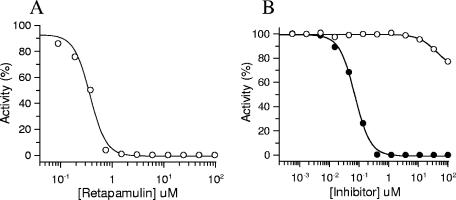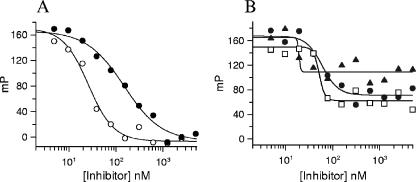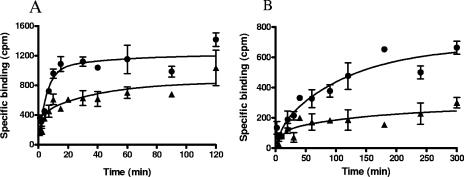
| Size | Price | Stock | Qty |
|---|---|---|---|
| 10mg |
|
||
| 25mg |
|
||
| 50mg |
|
||
| 100mg |
|
||
| 250mg |
|
||
| 500mg |
|
||
| 1g |
|
||
| Other Sizes |
|
Purity: ≥98%
Retapamulin (also known as SB-275833) is a novel and potent topical antibiotic of the pleuromutilin class approved by the FDA for treatment of impetigo in children. It binds to both E. coli and S. aureus ribosomes with similar potencies with Kd of 3 nM. It has low potential for the development of antibacterial resistance and a high degree of potency against poly drug resistant Gram-positive bacteria found in skin infections including Staphylococcus aureus strains. The drug is safe owing to low systemic absorption and has only minimal side-effect of local irritation at the site of application.
| ln Vitro |
|
||
|---|---|---|---|
| ln Vivo |
|
||
| Animal Protocol |
|
||
| References |
Antimicrob Agents Chemother.2006 Nov;50(11):3875-81. Epub 2006 Aug 28.
|
| Molecular Formula |
C30H47NO4S
|
|
|---|---|---|
| Molecular Weight |
517.76
|
|
| Exact Mass |
517.32
|
|
| Elemental Analysis |
C, 69.59; H, 9.15; N, 2.71; O, 12.36; S, 6.19
|
|
| CAS # |
224452-66-8
|
|
| Related CAS # |
|
|
| Appearance |
White to off-white solid powder.
|
|
| SMILES |
O=C(O[C@@H]1C[C@](C=C)(C)[C@@H](O)[C@H](C)[C@]2(CCC3=O)[C@]3([H])[C@]1(C)[C@H](C)CC2)CS[C@@H]4C[C@@](N5C)([H])CC[C@@]5([H])C4
|
|
| InChi Key |
STZYTFJPGGDRJD-QPCPVAGTSA-N
|
|
| InChi Code |
InChI=1S/C30H47NO4S/c1-7-28(4)16-24(35-25(33)17-36-22-14-20-8-9-21(15-22)31(20)6)29(5)18(2)10-12-30(19(3)27(28)34)13-11-23(32)26(29)30/h7,18-22,24,26-27,34H,1,8-17H2,2-6H3/t18-,19+,20-,21+,22-,24-,26+,27+,28-,29-,30+/m1/s1
|
|
| Chemical Name |
(3aR,4S,5R,7S,8S,9R,9aS,12R)-8-hydroxy-4,7,9,12-tetramethyl-3-oxo-7-vinyldecahydro-4,9a-propanocyclopenta[8]annulen-5-yl 2-(((1R,3s,5S)-8-methyl-8-azabicyclo[3.2.1]octan-3-yl)thio)acetate
|
|
| Synonyms |
SB-275833; SB 275833; SB275833; Retapamulin, trade names Altabax and Altargo.
|
|
| HS Tariff Code |
2934.99.9001
|
|
| Storage |
Powder -20°C 3 years 4°C 2 years In solvent -80°C 6 months -20°C 1 month Note: This product requires protection from light (avoid light exposure) during transportation and storage. |
|
| Shipping Condition |
Room temperature (This product is stable at ambient temperature for a few days during ordinary shipping and time spent in Customs)
|
| Solubility (In Vitro) |
DMSO : 104~110 mg/mL ( 200.86~212.45 mM )
Ethanol : ~104 mg/mL |
|---|---|
| Solubility (In Vivo) |
Solubility in Formulation 1: ≥ 2.75 mg/mL (5.31 mM) (saturation unknown) in 10% DMSO + 40% PEG300 + 5% Tween80 + 45% Saline (add these co-solvents sequentially from left to right, and one by one), clear solution.
For example, if 1 mL of working solution is to be prepared, you can add 100 μL of 27.5 mg/mL clear DMSO stock solution to 400 μL PEG300 and mix evenly; then add 50 μL Tween-80 to the above solution and mix evenly; then add 450 μL normal saline to adjust the volume to 1 mL. Preparation of saline: Dissolve 0.9 g of sodium chloride in 100 mL ddH₂ O to obtain a clear solution. Solubility in Formulation 2: ≥ 2.75 mg/mL (5.31 mM) (saturation unknown) in 10% DMSO + 90% (20% SBE-β-CD in Saline) (add these co-solvents sequentially from left to right, and one by one), clear solution. For example, if 1 mL of working solution is to be prepared, you can add 100 μL of 27.5 mg/mL clear DMSO stock solution to 900 μL of 20% SBE-β-CD physiological saline solution and mix evenly. Preparation of 20% SBE-β-CD in Saline (4°C,1 week): Dissolve 2 g SBE-β-CD in 10 mL saline to obtain a clear solution. View More
Solubility in Formulation 3: ≥ 2.75 mg/mL (5.31 mM) (saturation unknown) in 10% DMSO + 90% Corn Oil (add these co-solvents sequentially from left to right, and one by one), clear solution. Solubility in Formulation 4: 10% DMSO+40% PEG300+5% Tween-80+45% Saline: ≥ 2.75 mg/mL (5.31 mM) |
| Preparing Stock Solutions | 1 mg | 5 mg | 10 mg | |
| 1 mM | 1.9314 mL | 9.6570 mL | 19.3140 mL | |
| 5 mM | 0.3863 mL | 1.9314 mL | 3.8628 mL | |
| 10 mM | 0.1931 mL | 0.9657 mL | 1.9314 mL |
*Note: Please select an appropriate solvent for the preparation of stock solution based on your experiment needs. For most products, DMSO can be used for preparing stock solutions (e.g. 5 mM, 10 mM, or 20 mM concentration); some products with high aqueous solubility may be dissolved in water directly. Solubility information is available at the above Solubility Data section. Once the stock solution is prepared, aliquot it to routine usage volumes and store at -20°C or -80°C. Avoid repeated freeze and thaw cycles.
Calculation results
Working concentration: mg/mL;
Method for preparing DMSO stock solution: mg drug pre-dissolved in μL DMSO (stock solution concentration mg/mL). Please contact us first if the concentration exceeds the DMSO solubility of the batch of drug.
Method for preparing in vivo formulation::Take μL DMSO stock solution, next add μL PEG300, mix and clarify, next addμL Tween 80, mix and clarify, next add μL ddH2O,mix and clarify.
(1) Please be sure that the solution is clear before the addition of next solvent. Dissolution methods like vortex, ultrasound or warming and heat may be used to aid dissolving.
(2) Be sure to add the solvent(s) in order.
 |
|---|
 |
 |